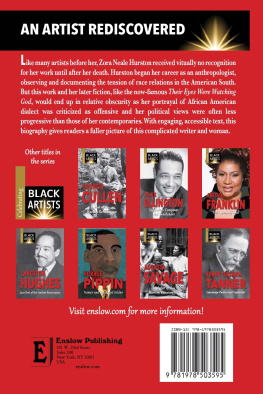Published in 2020 by Enslow Publishing, LLC.
101 W. 23rd Street, Suite 240, New York, NY 10011
Copyright 2020 by Enslow Publishing, LLC.
All rights reserved.
No part of this book may be reproduced by any means without the written permission of the publisher.
Names: Crompton, Samuel Willard, author. | Etinde-Crompton, Charlotte, author.
Title: Augusta Savage: sculptor of the Harlem Renaissance/Samuel Willard Crompton, Charlotte Etinde-Crompton.
Description: New York: Enslow Publishing, 2020. | Series: Celebrating black artists | Includes bibliographical references and index. | Audience: Grades 712.
Identifiers: LCCN 2018015719| ISBN 9781978503618 (library bound) | ISBN 9781978505360 (pbk.)
Subjects: LCSH: Savage, Augusta, 18921962BiographyJuvenile literature. | SculptorsUnited StatesBiographyJuvenile literature. | African American sculptorsBiographyJuvenile literature. | Harlem RenaissanceJuvenile literature.

Soft Florida Clay
D oes anyone know the precise moment at which an artist is born? Many painters, sculptors, and singers can identify the moment, saying it was when they first saw an easel, a pound of clay, or a working stage. Such stories help us understand the evolution of the artist. But the situation is distinctly more difficult for African American artists. Their white contemporaries struggle with many things, including the challenge to get their work recognized, but African Americans were oppressed for so long that many people believed it impossible for them ever to become great artists. That belief was and is, of course, thoroughly mistaken.
Making Art from Mud
Augusta Savage never tired of telling friends and acquaintances that she was a Leap Day baby, born Augusta Fells on February 29, 1892. She was born and raised in Green Cove Springs, a city 40 miles (64 kilometers) from Jacksonville, Florida. Green Cove Springs was a tourist locale, with many northerners who came south to enjoy the mild winters. But it was also a manufacturing city, where red clay bricks were produced. At an early age, Augusta played in the mud pits and used that Florida clay to shape figures, of animals and humans.

From an early age, Augusta Savage developed an interest in crafting animal figures.
This is as close as Augusta Savage ever came to describing her moment of discovery, the precise time at which her artistic path was launched. If her memory was accurate, she came to self-recognition as an artist at a very early age. The soft red clay of northern Florida was her easel, her stage, and her performers microphone, all rolled into one.
Throughout life, Savage displayed ambivalence about her upbringing. To some friends, she boasted of her father, Edward, a hard-working man who owned 15 acres (6 hectares) of land in their hometown. To others, Savage confided that her childhood had been very difficult. And the reason was not hard to find.
Edward Fells earned a meager living as a house painter, but he was also an assistant pastor at the local Methodist church. A true fundamentalist, Fells disliked what his daughter did: he saw her clay figures as examples of what the Bible calls the worship of graven images. His disapproval of his daughters art eventually translated into severe physical punishment.
How frequently did Edward beat his daughter? Perhaps as much as four times a week. By the time she was ten, Augusta Savage had practically all the art beaten out of her, as she later declared. Her fathers behavior is horrifying to our modern ears, but it was not atypical for that time. Early-twentieth-century parents believed it their duty to beat their children when necessary, to rescue them from the error of their ways.
Early Economic Hardship
I was born in Florida of poor parents. These are the opening words of Augusta Savages brief autobiography, penned for The Crisis, the leading African American periodical of the 1920s. In many ways, this short summation of her early circumstances said it all. In 1929, for a person to describe herself as black, poor, and living in Florida was quite sufficient. Almost everyone got the picture.
Florida had been part of the Confederate States of America. Its long history, which commenced with Spanish rule, was filled with slavery, poverty, and oppression. The typical Crisis reader, therefore, understood just what Augusta Savage meant. But she went further: I am the seventh child in a family of fourteen. Nine of us reached maturity. Contemporary readers may be appalled by the low survival rate, but Crisis readers were not. They knew that African Americans had a lower survival rate on average and that the rate of survival of those that lived in the Deep South was even worse. For the discerning Crisis reader of 1929, it was apparent that Savage and her family had a rather hard road in life.
Crisis readers went on to discover that when Savage first arrived in New York City, she had all of $4.60 in her pocket. This was not as unusual, or sensational, as it would be in our time. But it does indicate she was part of the Great Migration, the movement of hundreds of thousands of African Americans from the Deep South to the urban North.

Created in 1910 by W. E. B. Du Bois, The Crisis was the leading news and opinion publication for black Americans.
Biblical Fundamentalism
Today we employ the words fundamentalism and fundamentalist a great deal. The meaning they possess comes from the early twentieth century, the very time when Savage grew up in northern Florida. The fundamentalist movement derives its name from publication of The Fundamentals, a series of pamphlet-books issued between 1910 and 1915.
The First Move
The Fells family remained in Green Cove Springs until 1906 or 1907. This was, coincidentally, just about the high point for the city and vicinitythe time when the tourist trade was most successful. But the African American population was left out of the move toward prosperity. Postcards that survive show blacks as waiters and cooks, and occasionally as amateur musicians, but never as successful, middle-class citizens. Augusta and her family were not sad to leave. Edward Fells had gained a full-time pastoral position in a Methodist church in West Palm Beach. The family moved 350 miles (563 km) south, and their material circumstances improved. A new life beckoned.
Whether Augusta moved with her family is not certain. She married John Moore, a carpenter, just as her family was moving in 1907, when she was fifteen years old. The couple had a daughter they named Irene, but Moore died soon afterward. Augusta may have even stayed in Green Cove Springs until her husband passed away. But she did later rejoin the full family and spent her late teen years in West Palm Beach. It was around this time that Augusta came back to her art.


















